Efficiency Comparison of 2-Level SiC Inverter and Soft Switching-Snubber SiC Inverter for Electric Motor Drives
Abstract
:1. Introduction
2. SiC Power MOSFETs in Motor Drive Applications: Pros and Cons
3. Overvoltage Phenomenon in VFD Applications
4. Case Study: Design of the Snubber 2-Level Inverter
4.1. Inverter Power Semiconductor Selection
4.2. Snubber Circuit Design
4.3. Recovery Energy Circuit Design
4.4. DC-bus Capacitor Design
5. Experimental Results
6. Conclusions
Author Contributions
Funding
Institutional Review Board Statement
Informed Consent Statement
Data Availability Statement
Conflicts of Interest
References
- Jafari, A.; Nikoo, M.S.; Perera, N.; Yildirim, H.K.; Karakaya, F.; Soleimanzadeh, R.; Matioli, E. Comparison of Wide-Band-Gap Technologies for Soft-Switching Losses at High Frequencies. IEEE Trans. Power Electron. 2020, 35, 12595–12600. [Google Scholar] [CrossRef]
- Shenai, K. High-Density Power Conversion and Wide-Bandgap Semiconductor Power Electronics Switching Devices. Proc. IEEE 2019, 107, 2308–2326. [Google Scholar] [CrossRef]
- Tong, Z.; Gu, L.; Ye, Z.; Surakitbovorn, K.; Rivas-Davila, J. On the Techniques to Utilize SiC Power Devices in High- and Very High-Frequency Power Converters. IEEE Trans. Power Electron. 2019, 34, 12181–12192. [Google Scholar] [CrossRef]
- La Mendola, M.; Di Benedetto, M.; Lidozzi, A.; Solero, L.; Bifaretti, S. Four-Port Bidirectional Dual Active Bridge Converter for EVs Fast Charging. In Proceedings of the 2019 IEEE Energy Conversion Congress and Exposition (ECCE), Baltimore, MD, USA, 29 September–3 Octomber 2019; pp. 1341–1347. [Google Scholar]
- Hussain, M.W.; Elahipanah, H.; Zumbro, J.E.; Rodriguez, S.; Malm, B.G.; Mantooth, H.A.; Rusu, A. A SiC BJT-Based Negative Resistance Oscillator for High-Temperature Applications. IEEE J. Electron Devices Soc. 2019, 7, 191–195. [Google Scholar] [CrossRef]
- Funaki, T.; Balda, J.C.; Junghans, J.; Kashyap, A.S.; Mantooth, H.A.; Barlow, F.; Hikihara, T. Power Conversion With SiC Devices at Extremely High Ambient Temperatures. IEEE Trans. Power Electron. 2007, 22, 1321–1329. [Google Scholar] [CrossRef]
- Anderson, J.A.; Hanak, E.J.; Schrittwieser, L.; Guacci, M.; Kolar, J.W.; Deboy, G. All-Silicon 99.35% Efficient Three-Phase Seven-Level Hybrid Neutral Point Clamped/Flying Capacitor Inverter. Cpss Trans. Power Electron. Appl. 2019, 4, 50–61. [Google Scholar] [CrossRef]
- Di Benedetto, M.; Solero, L.; Crescimbini, F.; Lidozzi, A.; Grbovic, P.J. 5-Level E-type back to back Power Converters—A New Solution for Extreme Efficiency and Power Density. In Proceedings of the 2017 13th Conference on Ph.D. Research in Microelectronics and Electronics (PRIME), Giardini Naxos, Italy, 12–15 June 2017; pp. 341–344. [Google Scholar]
- Di Benedetto, M.; Lidozzi, A.; Solero, L.; Crescimbini, F.; Grbovic, P.J. Five-Level back to back E-Type Converter for High Speed Gen-Set Applications. In Proceedings of the IECON 2016—42nd Annual Conference of the IEEE Industrial Electronics Society, IEEE, Florence, Italy, 24–27 October 2016; pp. 3409–3414. [Google Scholar]
- Di Benedetto, M.; Lidozzi, A.; Solero, L.; Grbovic, P.J.; Bifaretti, S. ISOP DC-DC Converters Equipped 5-Level Unidirection-al T-Rectifier for Aerospace Applications. In Proceedings of the 2015 IEEE Energy Conversion Congress and Exposition (ECCE), Montreal, QC, Canada, 20–24 September 2015; pp. 1694–1700. [Google Scholar]
- Di Benedetto, M.; Lidozzi, A.; Solero, L.; Crescimbini, F.; Grbovic, P.J. Low-Frequency State-Space Model for the Five-Level Unidirectional T-Rectifier. IEEE Trans. Ind. Appl. 2017, 53, 1127–1137. [Google Scholar] [CrossRef]
- Di Benedetto, M.; Lidozzi, A.; Solero, L.; Crescimbini, F.; Grbovic, P.J. Small-Signal Model of the Five-Level Unidirec-tional T-Rectifier. IEEE Trans. Power Electron. 2017, 32, 5741–5751. [Google Scholar] [CrossRef]
- Klobucar, B.; Yuan, Z. 1200V Discrete CoolSiC(TM) MOSFETs in a Comparison with the Trenchstop HighSpeed IGBTs for High-Speed Spindles and Servo Drive System. In Proceedings of the PCIM Europe digital days 2020; International Exhibition and Conference for Power Electronics, Intelligent Motion, Renewable Energy and Energy Management, Nuremberg, Germany, 7–8 July 2020; pp. 1–6. [Google Scholar]
- Han, D.; Sarlioglu, B. Comprehensive Study of the Performance of SiC MOSFET-Based Automotive DC–DC Converter under the Influence of Parasitic Inductance. IEEE Trans. Ind. Appl. 2016, 52, 5100–5111. [Google Scholar] [CrossRef]
- Yang, Y.; Wen, Y.; Gao, Y. A Novel Active Gate Driver for Improving Switching Performance of High-Power SiC MOSFET Modules. IEEE Trans. Power Electron. 2019, 34, 7775–7787. [Google Scholar] [CrossRef]
- Morya, A.K.; Gardner, M.C.; Anvari, B.; Liu, L.; Yepes, A.G.; Doval-Gandoy, J.; Toliyat, H.A. Wide Bandgap Devices in AC Electric Drives: Opportunities and Challenges. IEEE Trans. Transp. Electrif. 2019, 5, 3–20. [Google Scholar] [CrossRef]
- Narayanasamy, B.; Sathyanarayanan, A.S.; Luo, F.; Chen, C. Reflected Wave Phenomenon in SiC Motor Drives: Conse-quences, Boundaries, and Mitigation. IEEE Trans. Power Electron. 2020, 35, 10629–10642. [Google Scholar] [CrossRef]
- Leuzzi, R.; Monopoli, V.G.; Cupertino, F.; Zanchetta, P. Comparison of Two Possible Solution for Reducing Over-voltages at the Motor Terminals in High-Speed AC Drives. In Proceedings of the 2019 21st European Conference on Power Electronics and Applications (EPE ’19 ECCE Europe), Genova, Italy, 3–5 Septemper 2019; pp. P.1–P.10. [Google Scholar]
- Rodríguez, J.; Pontt, J.; Silva, C.; Musalem, R.; Newman, P.; Vargas, R.; Fuentes, S. Resonances and overvoltages in a medium-voltage fan motor drive with long cables in an under-ground mine. IEEE Trans. Ind. Appl. 2006, 42, 856–863. [Google Scholar] [CrossRef]
- Skibinski, G.; Leggate, D.; Kerkman, R. Cable Characteristics and Their Influence on Motor over-Voltages. In Proceedings of the APEC 97—Applied Power Electronics Conference, Atlanta, GA, USA, 27 February 1997; Volume 1, pp. 114–121. [Google Scholar]
- Persson, E. Transient effects in application of PWM inverters to induction motors. IEEE Trans. Ind. Appl. 2002, 28, 1095–1101. [Google Scholar] [CrossRef]
- Pulsinelli, F.; Solero, L.; Chiola, D.; Sobe, K.; Brucchi, F. Overvoltages at Motor Terminals in SiC Electric Drives. In Proceedings of the 2018 International Symposium on Power Electronics, Electrical Drives, Automation and Motion (SPEEDAM), Amalfi, Italy, 20–22 June 2018; pp. 513–518. [Google Scholar]
- Kerkman, R.J.; Leggate, D.; Schlegel, D.; Skibinski, G. PWM Inverters and Their Influence on Motor Overvoltage. In Proceedings of the APEC—Applied Power Electronics Conference, Atlanta, GA, USA, 27 February 1997; Volume 1, pp. 103–113. [Google Scholar]
- Amarir, S.; Al-Haddad, K. Mathematical Analysis and Experimental Validation of Transient over-Voltage Higher than 2 per Unit along Industrial ASDM Long Cables. In Proceedings of the 2008 IEEE Power Electronics Specialists Conference, Rhodes, Greece, 15–19 June 2008; pp. 1846–1851. [Google Scholar]
- Zhao, F.; Xiao, G.; Zhu, T.; Zhao, T.; Zheng, X.; Wu, Z. Harmonic Analysis and Suppression Method of Output Current Distortion for Medium-Voltage Motor Drives with Modular Multilevel Converter. IEEE Trans. Power Electron. 2019, 35, 744–759. [Google Scholar] [CrossRef]
- Akagi, H.; Doumoto, T. An Approach to Eliminating High-Frequency Shaft Voltage and Ground Leakage Current from an Inverter-Driven Motor. IEEE Trans. Ind. Appl. 2004, 40, 1162–1169. [Google Scholar] [CrossRef]
- Zhou, W.; Diab, M.S.; Yuan, X. Mitigation of Motor Overvoltage in SiC-Device-Based Drives using a Soft-Switching In-verter. In Proceedings of the 2020 IEEE Energy Conversion Congress and Exposition (ECCE), Detroit, MI, USA, 11–15 October 2020; pp. 662–669. [Google Scholar]
- Yuen, K.K.-F.; Chung, H.S.-H.; Cheung, V.S.-P. An Active Low-Loss Motor Terminal Filter for Overvoltage Suppression and Common-Mode Current Reduction. IEEE Trans. Power Electron. 2011, 27, 3158–3172. [Google Scholar] [CrossRef]
- Parreiras, T.M.; Prado, B.M.P.D.; Filho, B.D.C. Common-Mode Overvoltage Mitigation in a Medi-um-Voltage Pump Motor Transformerless Drive in a Mining Plant. IEEE Trans. Ind. Appl. 2018, 54, 848–857. [Google Scholar] [CrossRef]
- Peng, F.; Su, G.-J.; Tolbert, L. A passive soft-switching snubber for PWM inverters. IEEE Trans. Power Electron. 2003, 19, 363–370. [Google Scholar] [CrossRef]
- Pulsinelli, F.; Di Benedetto, M.; Lidozzi, A.; Solero, L.; Crescimbini, F. Power Losses Distribution in SiC Inverter Based Electric Motor Drives. IEEE Trans. Ind. Appl. 2019, 55, 7843–7853. [Google Scholar] [CrossRef]
- Akagi, H.; Matsumura, I. Overvoltage Mitigation of Inverter-Driven Motors with Long Cables of Different Lengths. IEEE Trans. Ind. Appl. 2011, 47, 1741–1748. [Google Scholar] [CrossRef]
- De Caro, S.; Foti, S.; Scimone, T.; Testa, A.; Scelba, G.; Pulvirenti, M.; Russo, S. Motor Overvoltage Mitigation on SiC MOSFET Drives Exploiting an Open-End Winding Configuration. IEEE Trans. Power Electron. 2019, 34, 11128–11138. [Google Scholar] [CrossRef]
- Zhang, Y.; Li, H.; Peng, F.Z. A Low-Loss Compact Reflected Wave Canceller for SiC Motor Drives. IEEE Trans. Power Electron. 2021, 36, 2461–2465. [Google Scholar] [CrossRef]
- Parida, N.; Das, A. A Modular Multilevel Converter with Filter Capacitor for Long-Cable-Fed Drive Application. IEEE Trans. Ind. Appl. 2019, 55, 7833–7842. [Google Scholar] [CrossRef]
- Cai, M.; Wasynczuk, O.; Saeedifard, M. A Voltage-Edge-Rate-Limiting Soft-Switching Inverter Based on Auxiliary Reso-nant Pole. IEEE J. Emerg. Sel. Top. Power Electron. 2019, 7, 736–744. [Google Scholar] [CrossRef]
- Bellomo, J.P.; Lebey, T.; Oraison, J.M.; Peltier, F. Influence of Rise Time on the Dielectric Behavior of Stator Insulation Mate-rials. In Proceedings of the Conference on Electrical Insulation and Dielectric Phenom—CEIDP ’96, Millbrae, CA, USA, 23 October 1996; Volume 2, pp. 842–845. [Google Scholar]
- Fabiani, D.; Montanari, G.C.; Cavallini, A.; Mazzanti, G. Relation between space charge accumulation and partial dis-charge activity in enameled wires under PWM-like voltage waveforms. IEEE Trans. Dielectr. Electr. Insul. 2004, 11, 393–405. [Google Scholar] [CrossRef]
- Pei, X.; Zhou, W.; Kang, Y. Analysis and Calculation of DC-Link Current and Voltage Ripples for Three-Phase Inverter With Unbalanced Load. IEEE Trans. Power Electron. 2015, 30, 5401–5412. [Google Scholar] [CrossRef]

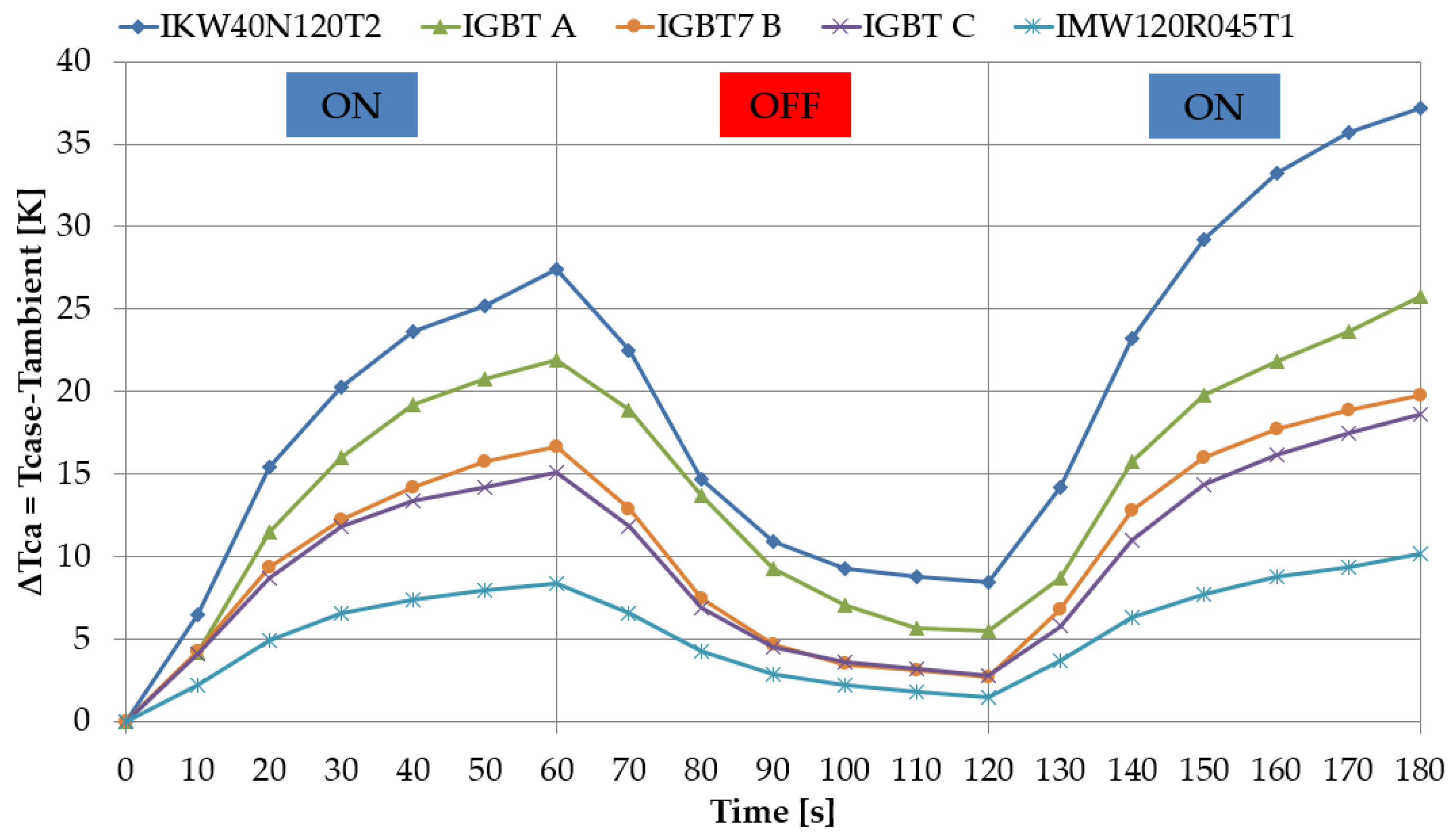


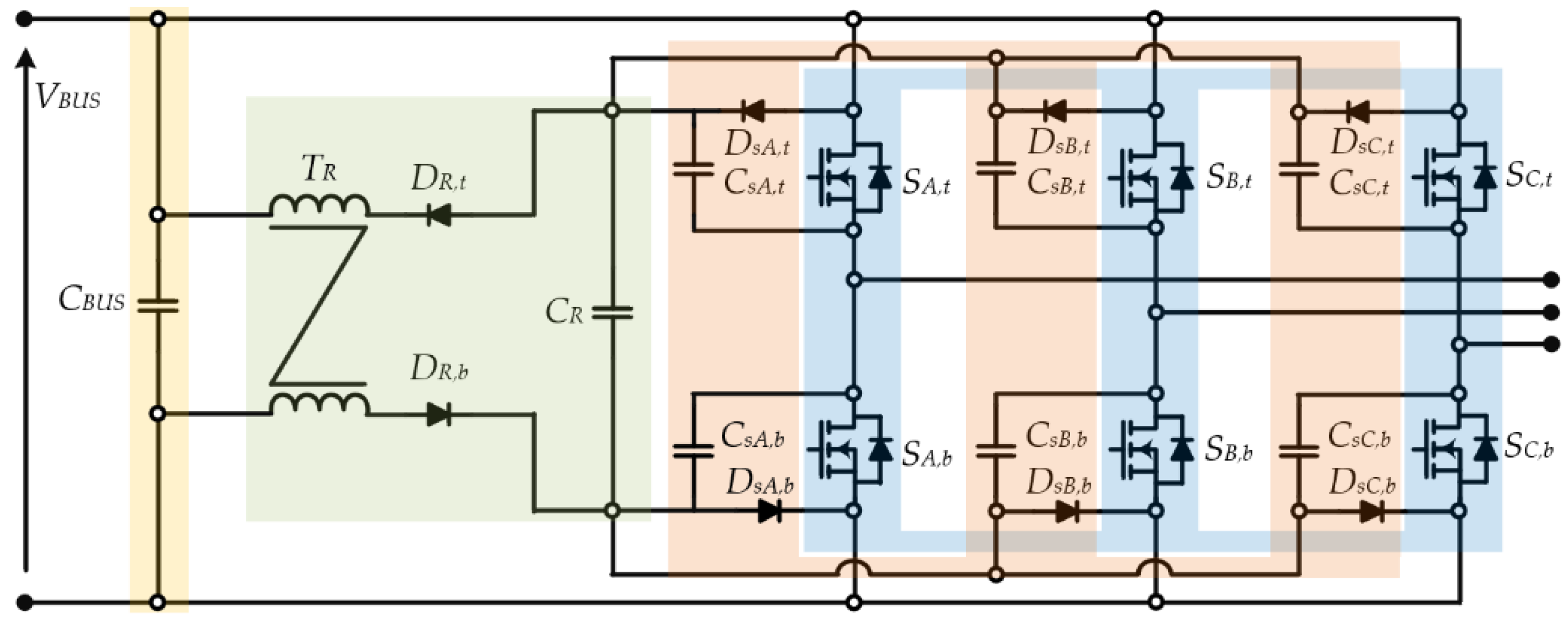


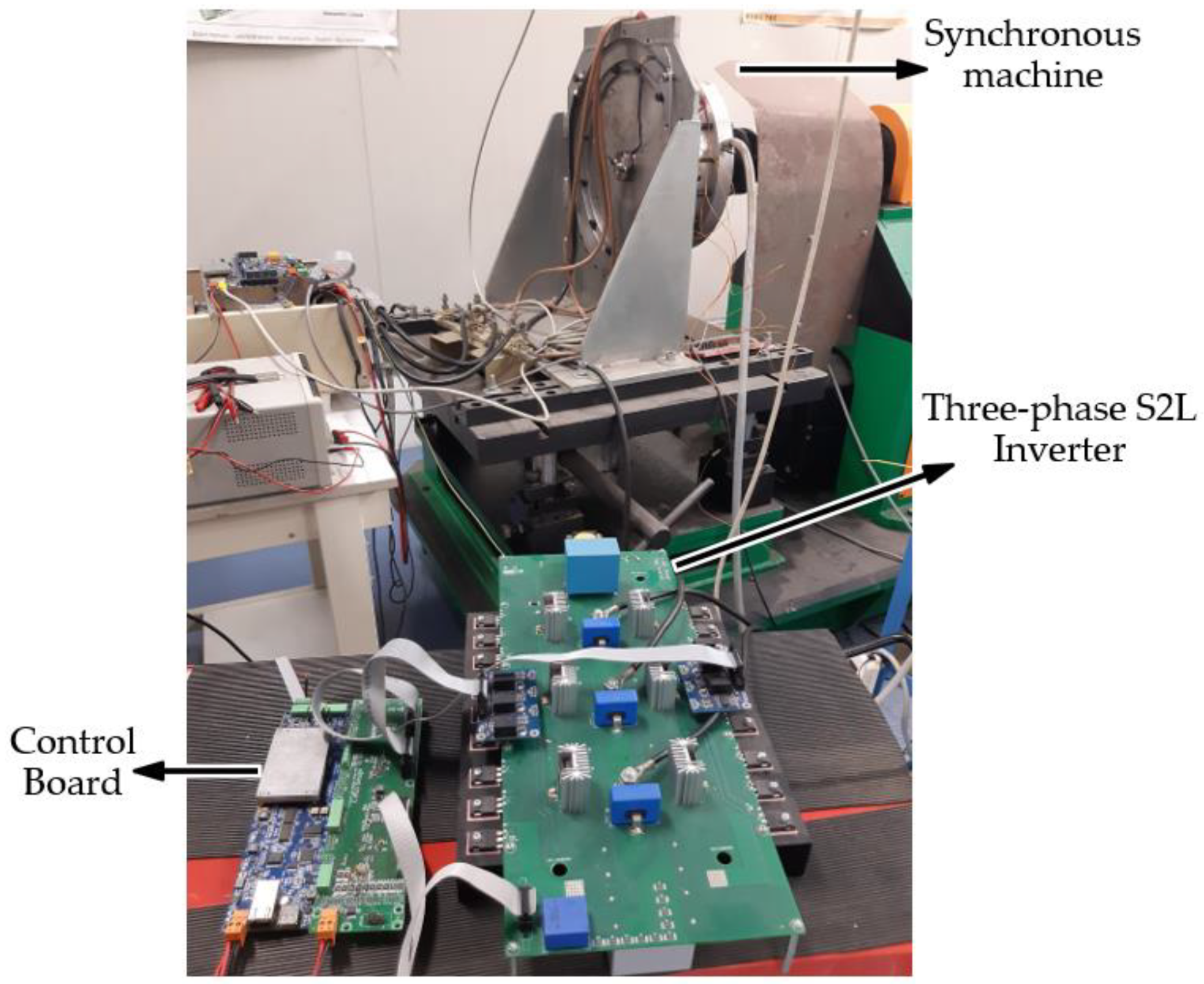
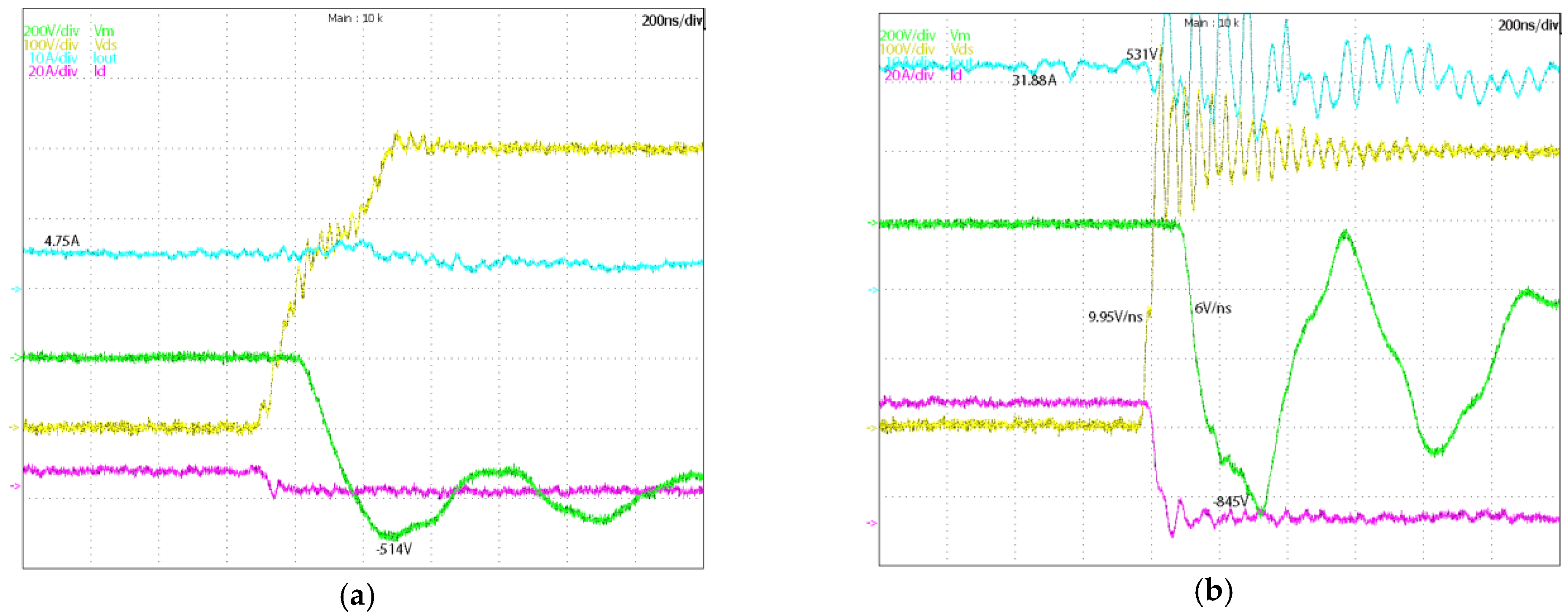
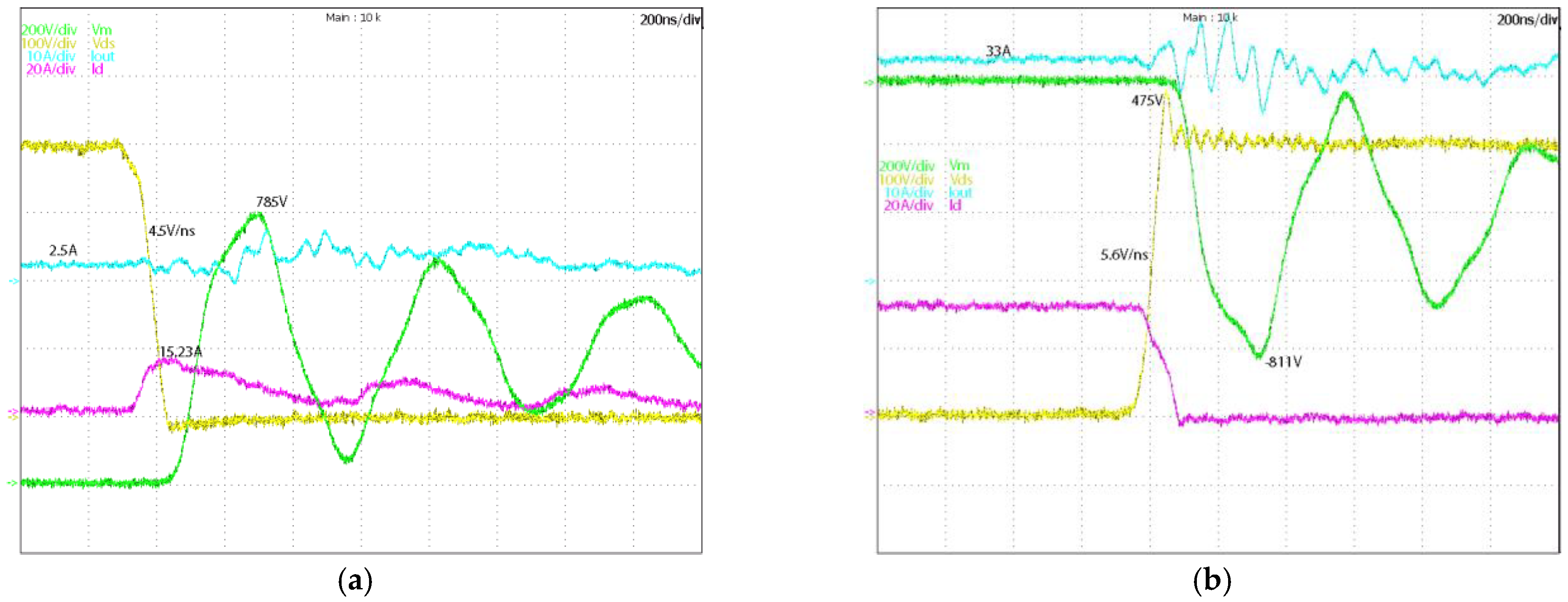
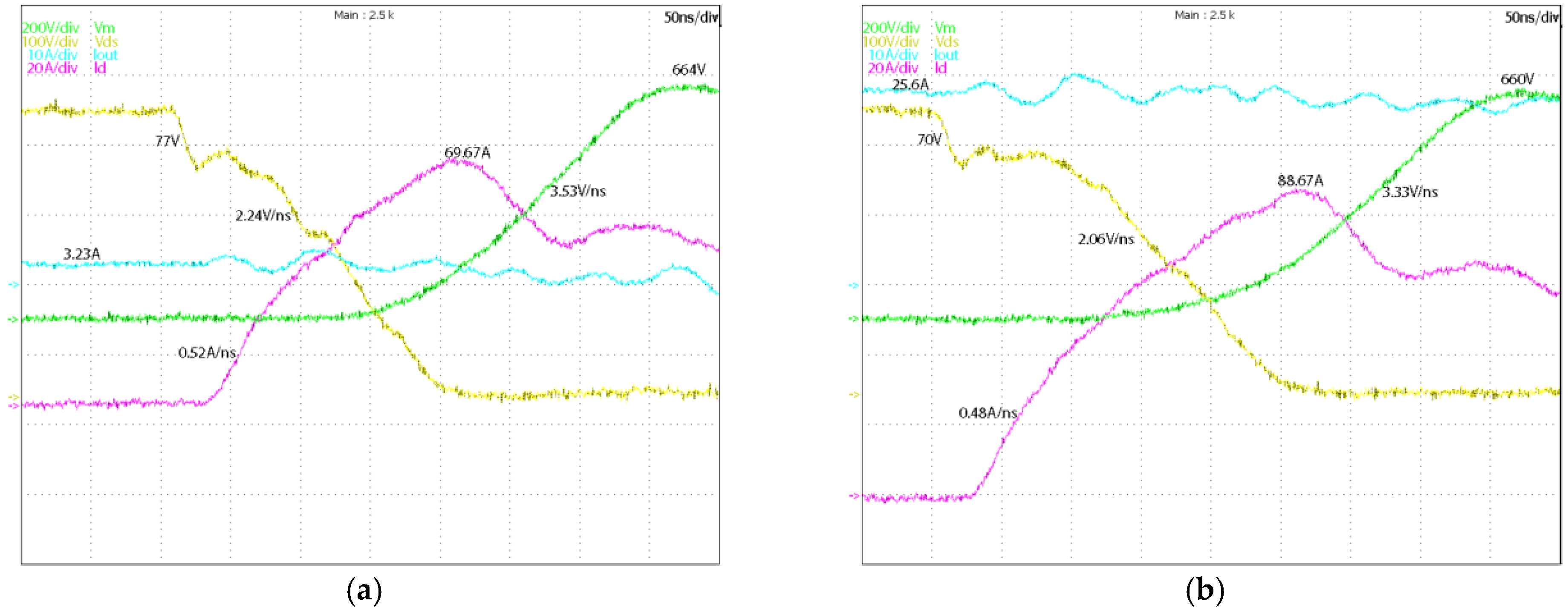

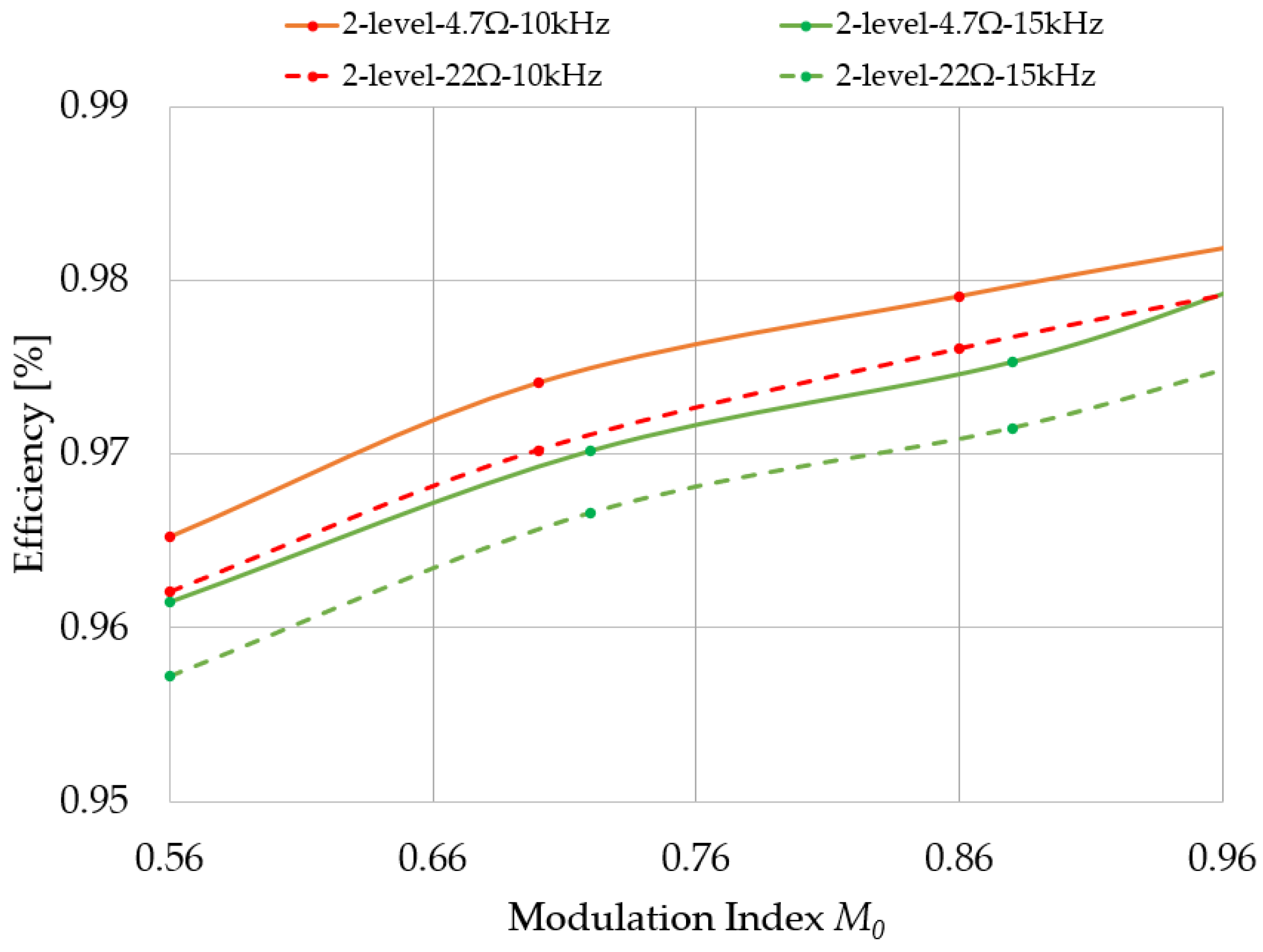
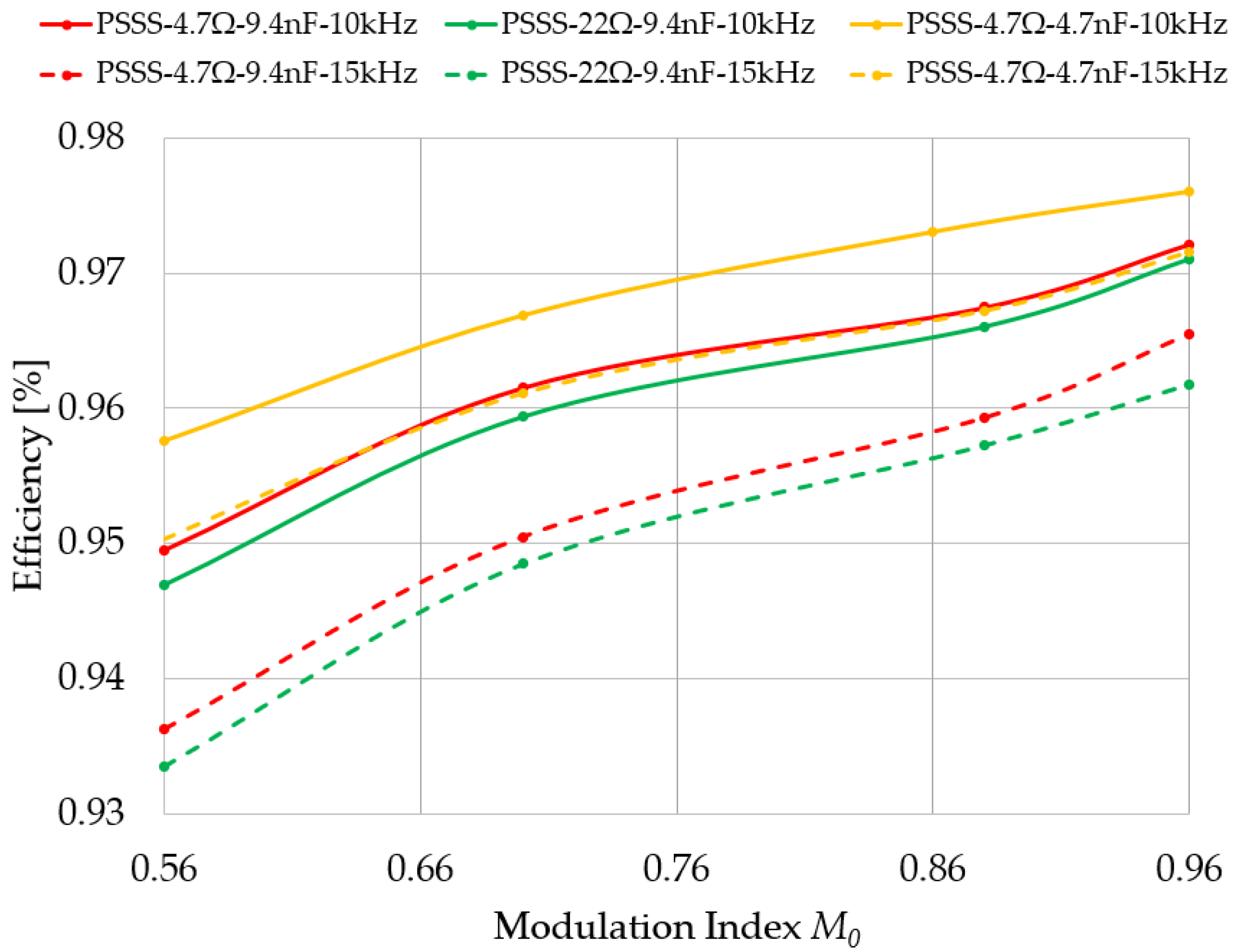
| Part Number | IKW40N120T2 | IGBT A | IGBT B | IGBT C | IMW120R045T1 |
|---|---|---|---|---|---|
| Package | TO 247-3 | TO 247-3 | TO 247-3 | TO 247-3 | TO 247-3 |
| Technology | Si | Si | Si | Si | SiC |
| RGon [Ω] | 20 | 47 | 20 | 10 | 33.2 |
| RGoff [Ω] | 21 | 48 | 21 | 11 | 33.2 |
| VGE or VGS on [V] | 12 | 12 | 15 | 15 | 20 |
| VGE or VGS off [V] | −15 | −15 | −5 | −5 | −5 |
| VBUS [V] | 330 | 330 | 330 | 330 | 520 |
| IPhase RMS [A] | 14.1 | 14.1 | 12.6 | 12.6 | 14.4 |
| Modulation depth M0 | 1 | 1 | 0.95 | 0.95 | 0.95 |
| fsw [kHz] | 10 | 10 | 10 | 10 | 10 |
| f0 [Hz] | 50 | 50 | 50 | 50 | 50 |
| Dead-Time [µs] | 1.8 | 1.8 | 1 | 1 | 1 |
| Reference | Part Number | Description |
|---|---|---|
| Sx,t, Sx,b | C2M0045170D | C2M0045170D: Cree SiC MOSFET 1700V-45mΩ-TO247-3 |
| Dx,t, Dx,b | IDW40G120C5B | IDW40G120C5B: Infineon SiC Diode 1200V-40A-TO247-3 |
| DSx,t, DSx,b | IDW40G120C5B | Infineon SiC Diode 1200V-40A-TO247-3 |
| CSx,t, CSx,b | 1812SC472KAT1A | AVX MLC Capacitor 4.7nF-1500V |
| DR,t,-DR,b | FFSD10120A | On Semiconductor SiC Diode 1200V-10A-DPAK |
| CR | MKP1848 | MKP1848: Vishay Film Capacitor 40µF 900V |
| TR | N.A. | ICE Mutual Inductor 1:1-800µH-4A-E42/20 Ferrite |
| CBUS | 5xMKP1848 | Vishay Film Capacitor 40 µF 900 V |
| Current Sensor | LA100-TP | LEM Current Transducer IPN = 100 A |
| Voltage Sensor | LV 20-P | LEM Voltage Transducer |
| Heatsink | SK 56/100 SA | Fischer Elektronik 300 mm × 100 mm × 40 mm |
Publisher’s Note: MDPI stays neutral with regard to jurisdictional claims in published maps and institutional affiliations. |
© 2021 by the authors. Licensee MDPI, Basel, Switzerland. This article is an open access article distributed under the terms and conditions of the Creative Commons Attribution (CC BY) license (http://creativecommons.org/licenses/by/4.0/).
Share and Cite
di Benedetto, M.; Bigarelli, L.; Lidozzi, A.; Solero, L. Efficiency Comparison of 2-Level SiC Inverter and Soft Switching-Snubber SiC Inverter for Electric Motor Drives. Energies 2021, 14, 1690. https://doi.org/10.3390/en14061690
di Benedetto M, Bigarelli L, Lidozzi A, Solero L. Efficiency Comparison of 2-Level SiC Inverter and Soft Switching-Snubber SiC Inverter for Electric Motor Drives. Energies. 2021; 14(6):1690. https://doi.org/10.3390/en14061690
Chicago/Turabian Styledi Benedetto, Marco, Luca Bigarelli, Alessandro Lidozzi, and Luca Solero. 2021. "Efficiency Comparison of 2-Level SiC Inverter and Soft Switching-Snubber SiC Inverter for Electric Motor Drives" Energies 14, no. 6: 1690. https://doi.org/10.3390/en14061690
APA Styledi Benedetto, M., Bigarelli, L., Lidozzi, A., & Solero, L. (2021). Efficiency Comparison of 2-Level SiC Inverter and Soft Switching-Snubber SiC Inverter for Electric Motor Drives. Energies, 14(6), 1690. https://doi.org/10.3390/en14061690







